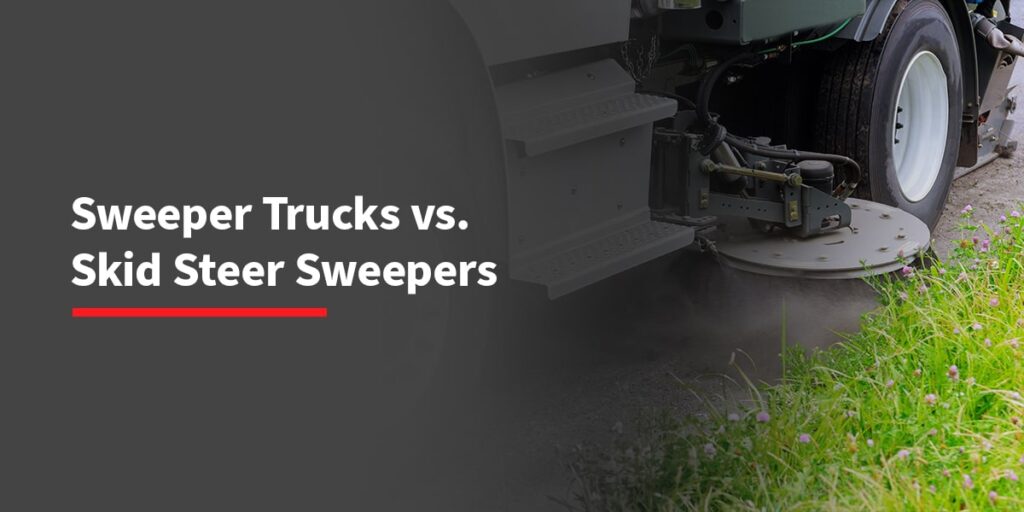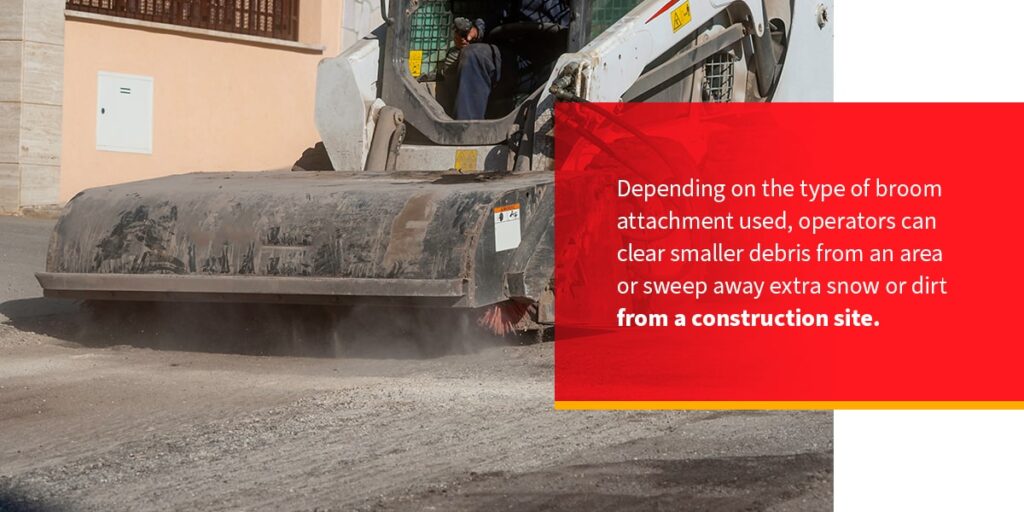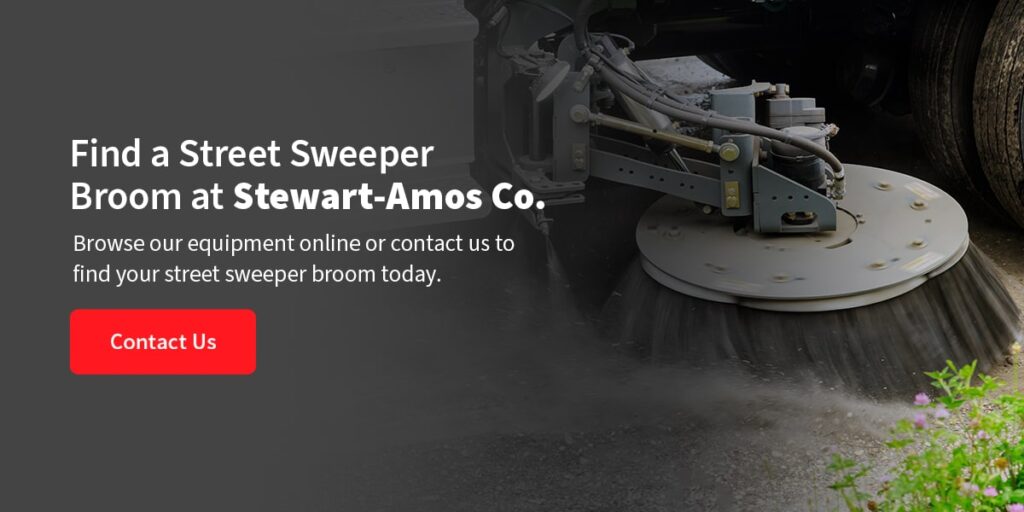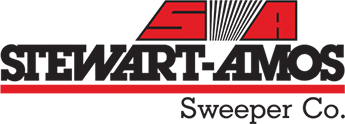
Construction sites that require regular cleaning and maintenance will need assistance from sweepers to keep the area clear of debris. Likewise, residential neighborhoods, city streets or factory floors may rely on sweepers to prevent storm drain or water contamination. Whether your company wants to use a sweeper truck or a skid steer sweeper, it’s essential to learn the differences between these machines and their various uses across work sites.
What Is a Skid Steer Sweeper?
A skid steer is a piece of versatile equipment used for digging at construction sites. Most skid steers are light and can easily maneuver around objects, while their arms attach to various tools used during construction and landscaping. Skid steers have four wheels or two tracks, and the front and back axles work simultaneously. Operators can use the machine separately from the wheels on the opposite side.
A skid steer operator turns the equipment by increasing the wheels’ speed on a specific side. That causes them to drag or skid across the ground, giving the machine its name. Skid steers have various attachment options, allowing the loader to perform several jobs. For example, many skid steers use a bucket attachment for lifting or moving heavy materials.
Skid Loader Broom Attachment
Skid steer loaders can also have a broom sweeper, which helps clean the ground and clear dirt or debris. Most broom attachments have poly or steel bristles mounted on a tube, while others offer a sweeper bucket. A hydraulic motor powers the broom that can turn in either direction to sweep dust into a bucket.
Like a broom and dustpan, the removable front broom attachment can sweep in reverse using the cutting edge of the bristles or clean forward using a brush against a rubber flap to collect materials in the bucket.
What Is a Sweeper Truck?
A sweeper truck is a cleaning vehicle that reduces the need for manual labor in neighborhoods or on streets and highways. Some trucks use conveyors or vacuum systems to collect material and clear the road. While the top speeds of most sweepers are in the 25 mph range, chassis-mounted street sweepers can go faster. However, the trade-off is that speed-related accidents can be more likely with chassis-mounted trucks.
A few components of sweeper trucks differentiate them from skid steers.
- Brooms: Sweeper trucks use cylindrical brooms to clear dirt and debris.
- Flaps: Brushes use flaps to protect the truck from flying debris or material.
- Blower: A blower releases the collected dust into the machine.
- Hopper: Collected material goes into a hopper for later removal.

What Are the Common Applications for Skid Steer Sweepers?
Skid steer broom applications are extensive. Depending on the type of broom attachment used, operators can clear smaller debris from an area or sweep away extra snow or dirt from a construction site.
The two common broom types are pickup and angled. Typically, skid steer sweepers clean floors in warehouses, parking lots or sidewalks. During construction, operators can use brooms to scrape excess mud from the road, clean the site efficiently or spread materials across the area. You must understand how both types of brooms function to decide which will work better for specific jobs.
Skid Steer Pickup Broom
A pickup broom sweeps, collects and dumps debris using an attached bucket underneath the skid steer. Because skid steers are bidirectional, a pickup motor can collect waste while driving up toward a building or loading dock and brush dirt into the bucket while backing up.
Construction workers often use pickup brooms to reduce the amount of debris and clean the area. They also come in handy at docks, warehouses, roadways or sidewalks and can clear dirt after snow melts. Due to their simple design, pickup brooms reduce dust and work well in areas where environmental laws or regulations require dust suppression.
These broom types are also good at lowering the chance of flying stones or damaging debris that might harm buildings or working vehicles. Pickup brooms are most suitable for heavier material that an angled sweeper does not easily remove.
Skid Steer Angled Broom
As its name suggests, an angled broom operates at an angle from the left or right. These brooms sweep snow, dirt or leaves away from the loader and off the work area’s surface. You can find them in parking lots, streets or factory floors.
While angled brooms work well for light snow removal, operators can also use them during turf applications where skid steers may use brooms. Since this type of broom lacks capture abilities, it may be less useful in areas where dust control is a priority. Angled brooms are excellent for sweeping debris from a work location, but require caution in residential areas where brooms might push the material into people’s yards or driveways.
Sweeper Truck Applications
When deciding whether to use a skid steer sweeper or sweeper truck, it’s essential to understand each machine’s uses. A sweeper truck can prevent hazardous material or debris like oil and solvents from entering storm drains, rivers or lakes.
By gathering dirt and material, sweeper trucks assist in saving fish and local wildlife from contamination while also extending the life of street asphalt or workplace concrete by removing dirt from the cracks and crevices of the area. Sweeper trucks can also make a curb more appealing, control dusty areas or pick up dangerous items like nails and glass.
What Are the Limitations of a Skid Steer Sweeper?
Skid steer sweepers have many uses with few limitations. To use the sweeper and attached broom to the best of its ability, keep the machine well-maintained and operate it correctly. Here are a few aspects to remember when running a skid steer sweeper.
- Broom width: Choose a broom with a sweeping width that is wider than the loader’s tires or tracks. Any broom wider or smaller than the tires may limit accessibility or cover less surface area.
- Machine flow rate: Understand the operating flow rate to ensure the motor warranty does not void or lead to premature failure.
- Correct storage: Storing polypropylene brushes in the sun can cause the material to crumble or deteriorate. To prevent deformed bristles, do not store brooms with any excess weight.
- Correct operation: Avoid bouncing the broom head when operating the machine or putting excess weight on the broom wafers, which can cause premature failure. Quickly changing the broom rotation may also damage the motor.

Find a Street Sweeper Broom at Stewart-Amos Co.
At Stewart-Amos Equipment Co., we offer high-quality street sweeper brushes to fit various makes and models and ensure road safety and cleanliness. Our brush types include tube, gutter, wafer and strip brooms that operators can use during construction, material handling or aggregate applications. Stewart-Amos Equipment Co. has various reliable and trustworthy equipment that serves our customers’ specialized needs. Browse our equipment online or contact us to find your street sweeper broom today.
